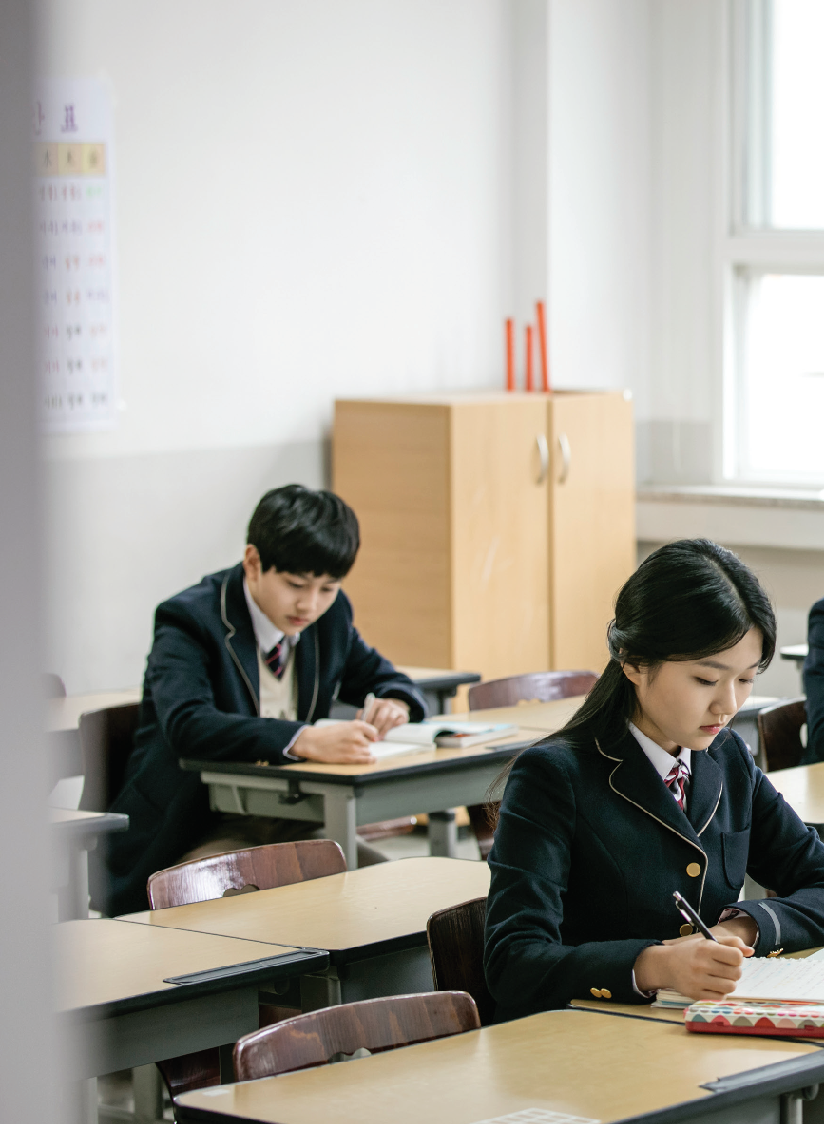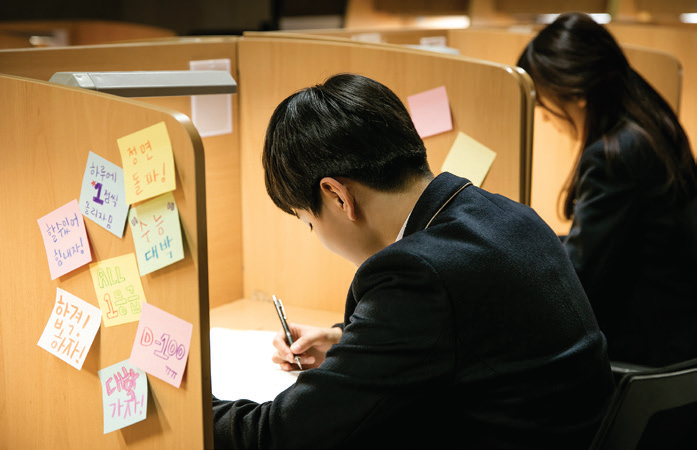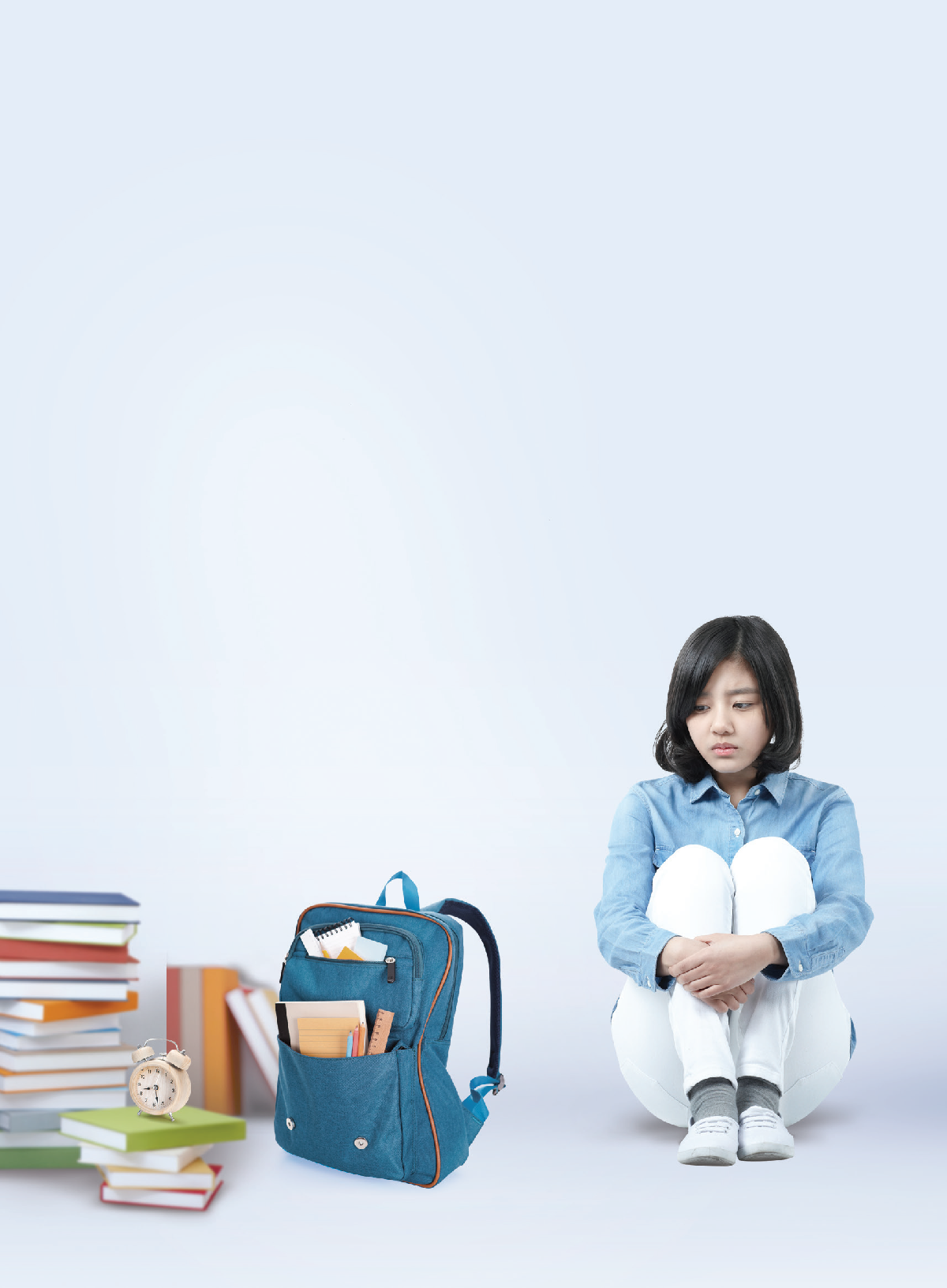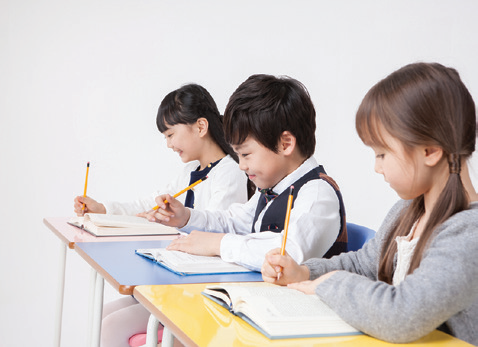

You Da-yeon, Editor/ Kwon Jong-hwan, Reporter
In January 2019, there was a TV drama that hit Korea: SKY Castle. This drama’s popularity resulted from criticism about Korean educational zeal. In the drama, characters want to keep their children’s social class with specialized job. Then, why do they want to keep their class? Let’s find about Korean educational zeal and what happens in Korea.
● The Connection between Social Class and Educational Zeal

The theory of the spoon, such as a golden spoon or dirty spoon, is used when many Koreans sneer at their own low class, signifying that parents’ class passes down directly to their children. Also, in today’s society, it is not easy to rise from a humble family. Parents want their children to have an upper class lifestyle, by working in a specialized job. This social phenomenon brought out the significance of educational zeal.
When people ask Koreans about private education, they might answer Daechi-dong, Gangnam-gu, Seoul, the Mecca of private education. Why is Daechi-dong so popular? Daechi-dong was originally an area where people, who reached an upper class status or ranking by working in specialized jobs, lived. In order to maintain their social status, they focused on private education for their children. This phenomenon spread into major big cities in Korea, and they in turn formed their own private education district. Daechi-dong, Gangnam gained recognition through the private education boom in the 1990s and from then, it grew into the district which has the most private educational institutes in Seoul. Daechi-dong boasts 10% of Seoul’s entire private institutes. If you visit Daechi-dong, you can see buildings over ten floors packed with institutes with focus on subjects such as Korean language, English, Mathematics, Science, Social studies and even essay writing. This shows how complicated and hard, not to mention competitive, the Korean private education system for students.
Then, why is educational zeal in Korea so important? First of all, Parents began to see that investing in their children’s education would raise the social status of the family. However, parents started investing too much money, far above their own personal incomes, into their children’s education. In addition, Korean society was becoming too competitive. So, as soon as a Korean child was born, learning to walk, entering school and going to university, marriage and work all became very competitive. This societal competitiveness made some of them tired of competition and is why many Koreans immigrate to other countries. Among them, educational zeal is thought to have specially originated from the competition to enter universities in Seoul. In Korea, many people agree that this country is the “Republic of Seoul,” because most of the domestic news is focused on Seoul, and most of Korea’s social infrastructure is anchored in Seoul. Even, Korea’s economic development is also based near Seoul and all companies should be headquartered in Seoul to get good, talented and skilled employees. So, students want to enter universities in Seoul and enter companies in Seoul. These phenomena makeup Korea’s so-called educational zeal.

● Symptoms of an Educational Zeal
1. The Shock of Radish Juice
In 1964, there was an incident at the entrance test of a middle school in Seoul. In the Science section, the 18th question asked, ‘What ingredient can make Korean hard taffy instead of yeast?’ The answer was diastase, but parents of some failed student who chose radish juice protested and made Korean hard taffy with radish juice. So, the Seoul High Court declared that radish juice was also a possible correct answer and those who chose radish juice could enter middle school. This anecdote shows how intense parents' zeal for education is. 
2. Admission to both Stanford and Harvard University
In 2015, one student became popular in Korea because she passed the entrance exams for both Stanford and Harvard universities. There were many students who passed those two universities, but they could enter only one of them. However, she was permitted to enter both schools because of her wizardly math ability. This became a hot issue in Korea until a media reporter contacted both universities and discovered that there had been no such student who entered both universities. So her lie was exposed to the rest of Korea. This issue seemed to have been forgotten but was remembered again because of the very popular drama, ‘SKY Castle’. Cha Seri, who is a character in this drama pretends to be a Harvard university student. In the drama, she was fined $62,000 because she took classes, used the student dormitory and committed other misleading acts. This character is based on a real-life student who lied that she had entered both Harvard and Stanford. 

● Analysis of an Educational Zeal 
Korean language, Mathematics, English, Science, Social studies and Korean History are required subjects for every high school student in Korea under all circumstances. You don’t need to do everything well depending on your major. However, if you want to get into universities in Seoul, you have to get good grades in almost every subject. Especially, Mathematics, English, and Korean language are the most important and constitute a large portion of your overall grade. Consequently, students must spend most of their time starting in high school to consistently and efficiently manage all subjects. With this necessity, receiving academic private education is very beneficial.
Statistics Korea’s Research says that average age when Koreans start their first private education is four to five, which means Koreans rely on private education even before they enter elementary school. Also Korean spends monthly 271,000₩ per student and this cost is still showing upturn in 2018. Especially if you look at the private spending on education of high school students and middle students, each 284,000₩ and 291,000₩, you can see why Korea spends 50% of its GDP in education to their primary and secondary. Furthermore, time spending of private education is weekly 6.7, 6.4 and 4.9 hours in elementary, middle, high school student each. This indicates all elementary student use at least one hour a day to take private education.
You may think this research isn’t a big deal, or that one hour a day isn’t a burden. However, this is not all-inclusive. This researches only indicates the number of hours of private lessons, not the time and cost of commuting to and from school, doing homework and independent study. Consequently, elementary-aged students have to study more than five hours every day, not to mention middle and high school students who have to study more than seven to eight hours a day, in addition to their regular school hours. So, it isn’t surprising that almost every student in Korea often hears, “If you want to receive a better grade than others, you must study more than ten hours a day!”
● Analysis of the Other Side of Korea’s Educational Zeal

The circumstances of non-academic education are not much better. A recent article by Hankook Ilbo saying the cost of private education for an art college entrance examination shocked to Koreans. The article said, ‘If you take lessons for an art college entrance exam for two months, it will cost more than 8,000,000₩.’ The Seoul Metropolitan Office of Education announced the cost of non-academic private education. Surprisingly, the cost of private lessons for entrance an art school entrance exam such as, music and dance, costs a minimum of 130₩ to 344₩ per minute! It costs at least 7,800₩ per hour! Considering most of these institutes recommend 12 hours of education per day, five days a week, it isn’t a small amount.
The process of these lessons is another problem. Special lessons for art, music and dance pose the danger of uniformity. An institute’s goal is for their student to pass an entrance examination, not to nurture an esthetic development of each student. Consequently, they concentrate on teaching how to pass an exam, not necessarily how to develop a student’s individual ability. Most of these lessons are primarily composed by imitating former applicants who passed the entrance exam with excellent results. Many students must do what those successful students did, not what they themselves want to do. Furthermore, university’s entrance examination, which cannot ban this kind of unification are making institutes stronger and firmer each year.
This phenomenon doesn’t only affect those who take these lessons, but it affects every non-academic student who hasn’t taken any of these lessons. Major large institutes produce hundreds of students who passed entrance exams of prestigious universities in Seoul. In many ways, students who have taken special lessons have many advantages over other students. Naturally, special lessons have become an integral part of the supplementary education system creating a necessary niche in Korean society that continues annually each year, and helps these institutes grow and become larger! Therefore, the continuative vicious circle is becoming more solidified each year, forcing Korean families to send their children to receive private education.
● Side Effect of an Educational Zeal

If a family has a third child, 150% of the family’s total income would need to go to private education. Rather unrealistic for many families today, especially in Jeonju. This means that families often cannot afford the educational cost of a third child. Another reason for the decrease in birth rate is from students suffering from oppression, denying themselves the privilege of relationships. “If you get a girlfriend when you are in high school, both of you will regret your decision of getting into a relationship.” This is another consideration of the younger generation of Koreans today. Students simply have no time to do anything else except study for over ten hours a day. Naturally this makes students avoid any kind of relationship with the opposite sex.

● Prescription for Educational Zeal
Many problems are presented in this article, and if there is a problem, there should be a solution for each problem. There are two possibilities to solving this so-called educational zeal. First, society should narrow the gap between the rich and the poor. Most of education is demanded not only to satisfy curiosity but also to keep their social class standing.
Second, it seems paradoxical, but low birthrate is the other solution to solve educational zeal. In a society which has a decreasing birth rate, students can choose their universities or major subjects they would prefer to pursue. Also, it could solve youth unemployment.

“You can enter university in USA laughing, but you have to work hard to graduate. On the contrary, in Korea, you have to work hard to enter university, but you can graduate easily.” This Korean expression shows Korea’s educational zeal toward attaining a university degree. On the one hand, Korean’s educational zeal is evaluated as a driving force of Korea’s growth in the global market.
In contrast, this zeal also points to the reason behind Korea’s low happiness exponent and high suicide rate. Recent OECD research found out that Korea’s university entrance rate, which has stayed above 70% since 2001, fell to 69% in 2016, and is still declining in 2019. Can this be Korea’s first step toward solving overheated fever of education?

